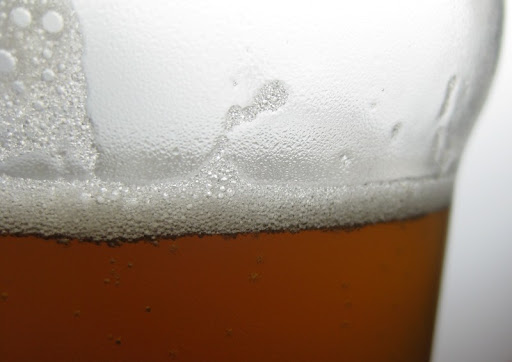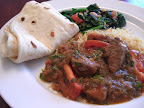Rye IPA - Partial Mash Recipe

Ever since we first had a pint of Alpine Beer Company's Nelson Golden Rye IPA, we have been wanting to brew a "RyePA". Given that we didn't have any of the New Zealand Nelson Sauvin hops that Alpine's beer is named after, creating a Nelson clone was out of the question. Still, we figured we could take a shot at the "Golden Rye IPA" part.
The rye in our recipe is whole malted rye grain. Rye malt is not available in extract form, which was one of our motivations for moving to partial mash brewing.
This is what the rye looks like cracked:

Definitely darker in color than malted barley - below you can see them together for comparison:

Rye has twice the coloration potential as barley - about 3.7L vs 1.8L (the "L" stands for Lovibond, a unit of color measurement). Given this, we were a bit worried that we would not be able to achieve the bright, golden, "West Coast IPA" look that we wanted. Our standard IPA recipe uses a bit of crystal malt specialty grain, but to counter the increased color potential, we were careful to use a very light version (10L) - we even considered dropping it altogether.
Color wasn't a problem, though, as you can see here:

Exactly what we were going for. Pretty much the same color as our Blind Pig ("Piggish") clone. We used very similar recipes for both beers, with exception of substituting rye for about 12% of the grain in the mash and increasing the hops in secondary.
Below, you can see the two beers side-by-side (the rye is on the right):

Any perceived difference in color is mostly due to lighting - they looked virtually identical save for a difference in carbonation.
And the taste? Also similar, yet different. I would say that the rye added a more round and complex malt flavor. We've tasted them together a number of times now: sometimes I prefer one, sometimes the other. Depends on my mood. A little variety (even if subtle) is nice to have, though, and we'll definitely be making this beer again.
Piggish Rye IPA
Total batch size = 5 gallons; Partial Mash in 3 gallon beverage cooler; ~3 gallon 60 minute stove-top boil; very late malt extract addition; dry hopped for aroma; target abv of 6.5%.
3 3/4 lb 2-Row Pale Malt
3/4 lb Rye Malt
1/2 lb 10L Crystal Malt
1/2 lb Carapils/Dextrin Malt
1/2 lb Wheat Malt
4 1/4 lb Briess Golden Light Dry Malt Extract (DME)
2 oz Columbus Hops (12.3% AA)
2 oz Cascade Hops (6% AA)
1 1/2 oz Simcoe Hops (13.2% AA)
1 oz Centennial Hops (8% AA)
1 tablet Whirlfloc
White Labs WLP001 California Ale Yeast
4 oz corn sugar (for bottle priming)
1 oz Columbus - 60 minutes boil
1/2 oz Cascade - 30 minutes boil
1 oz Cascade - 15 minutes boil
1/4 oz Columbus - 2 minutes boil
1/2 oz Simcoe - 2 minutes boil
1 oz Columbus - Dry Hop in Secondary Fermenter
1/2 oz Cascade - Dry Hop in Secondary Fermenter
1 oz Simcoe - Dry Hop in Secondary Fermenter
1 oz Centennial - Dry Hop in Secondary Fermenter
Heat 8.25 quarts water to 165 degrees for a target mash temperature of 150-153 degrees. Place the 6 pounds of crushed grain (2-Row Pale, Rye, 10L Crystal, Carapils and Wheat) into a large mesh bag. Pour the hot water into the beverage cooler, then lower the grain bag into the water very slowly, pushing and prodding with a large spoon to ensure all the grain is wet (this can take several minutes). Put the lid on the cooler and allow to rest 60 minutes.
While the grains are mashing, heat another 4-5 quarts of water to 180-185 degrees for sparging (rinsing the grains). Near the end of the 60 minutes, heat 2 quarts of water to a boil in your brew pot.
After the first mash is complete, remove the cooler lid and open the spigot to draw off about 2 quarts of wort into a large pitcher. The first few draws will likely be cloudy with grain particles; if so, pour it gently back into the cooler over the grain bag to help filter it. Draw off the remaining wort by the pitcher-full and carefully pour that wort into the boiling water in your brew pot; continue until only a trickle of wort leaves the spigot.
Pour about 4 quarts of your hot sparge water over the grain bag in the cooler. Gently lift the bag up and down to thoroughly re-wet the grains (but don't slosh). Cover and let sit about 5 minutes. Use the spigot and a pitcher to draw off all of the second wort and add it to your brew pot. You should have about 3 gallons of wort.
Bring the wort to a boil and add hops according to the schedule. At time zero, remove from heat and add the DME one pound at a time, stirring to dissolve (alternatively, with 15 minutes left, carefully begin adding DME by the cup-full, stirring well between each addition; at time zero, add the remaining DME off the heat). Stir in 1 tablet Whirlfloc. Cover and let sit 10-15 minutes.
Move brew pot to an ice bath and cool quickly to less than 80 degrees. Transfer wort to a primary fermenter, straining most of the hops. Add water to reach the 5 gallon mark. Swirl vigorously then pitch the yeast.
Ferment in primary for 1 week, then transfer to secondary and dry hop with 1 oz Columbus, 1/2 oz Cascade, 1 oz Simcoe and 1 oz Centennial. Bottle or keg after fermentation is complete (2 to 3 weeks in secondary).







It truly is a beautiful color and boy, look at all of those hops! Wonderful. I bet it tasted excellent.
ReplyDeleteHi Mike - yep, it tastes great. And it is almost gone :-(
ReplyDeleteWow that looks sooo good! I Love IPA. Ive never made beer before, It looks like lots of patience is required.
ReplyDeleteHi Masa - making beer requires a bit of time, but is definitely worth the effort.
ReplyDeleteNice. I recently started all grain. Pretty easy for single infusion mashing. I use pretty simple equipment too. I'll have to post about it sometime.
ReplyDeleteI'm thirsty!
Hi Dave - we would love to go all-grain, but we don't really have enough outdoor space for a full boil. Partial mash is a good compromise for us since we can still do a stove-top boil.
ReplyDeleteahhh...beer.
ReplyDeleteHow I need to take a serious crash-course in it!
would help if was 'of age', ha, ha.
thanks, will do upcoming posts on events to let you in on the know.
hope to see you soon--
Very impressive recipe. It looks very good. I've tried partial mashing myself. It's definitely far superior to all-extract brewing. Much greater control and range of taste/style can be achieved. I've made two 5 gallon batches partial mashing so far, a porter and a brown ale. I may have to try this rye IPA.
ReplyDeleteThanks, John. We've been very happy with partial mashing. We started doing it for this beer because we had to (since you can't get extract rye), but we've kept using it for all our batches since.
ReplyDeleteBrewed this 2 days ago. Looks like a great solid recipe. I used a quart starter and had visible fermentation in just under 24 hours. Will update when I crack my first! Thanks!
ReplyDeleteHi Erik - definitely let us know how it turns out!
ReplyDeleteLetting you know that within the Barossa wine region of South Australia, there is the Tanunda agricultural show held yearly in March. Thought I'd enter for my first ever comp a Piggish Rye IPA: subbing in Centennial, Amarillo, Simcoe and US-05 yeast!
ReplyDeleteFirst ever mash full stop. New equipment and feeling like an utter noob - getting temps right, spilling hot wort and all alone in the kitchen.
Gotta thus thank yourselves as the purveyors of a great recipe, clear instructions, a most loved beer and a third place within the American IPA class!! 3 points between it and the winning brew :)
Have just put down a FG version of this beer and shall be attempting the Imperial Stout this weekend - winter approaches.
Thanks for a wonderful site and being particularly adventurous with the with raw meat and tasty beer.
Hi aidee - congrats on your award-winning brew!
ReplyDeleteHey Mike,
ReplyDeleteDid you dry hop with pellets or whole leaf?
Also, if I was able to get my hands on some of the Nelson Sauvin hops, how would you work them into the hop bill and schedule?
ReplyDeleteHi Tom - we've used both leaf and pellets, although we're using mostly pellets these days.
ReplyDeleteCoincidentally, we picked up some Nelson Sauvin pellets just the other day. Haven't used them yet, though. Given that Alpine's Nelson is such a fantastic beer, I could definitely see using some in this recipe. I would suggest late in the boil and/or as a dry hop.
I just discovered this recipe a few weeks ago and it inspired me to try my first partial mash beer. I used the grain profile from this recipe and made up a hop schedule using Nelson and Cascade, brewed it last weekend and it's smelling great. A couple questions however:
ReplyDeleteI plugged all this stuff into the Beer Calculus recipe thing and it spit out an OG of 1.067 with a target ABV of 6.8%, assuming 75% efficiency on the mash. Did you calculate your efficiency? I didn't calculate mine (didn't realize how until after) but it had to have been way low, my OG was 1.041. As far as I can tell my method and equipment was exactly the same to yours and the temp even seemed to be the same for the mash.
Regardless the beer will be tasty if a little less robust than yours. Thanks for the inspiration and the base recipe, I loved doing a partial mash!
I really like the idea of rye beers, especially the IPAs. But... when I first tried them I was mistakenly thinking I was going to get something more akin to rye bread, i.e. caraway flavor. Have you given any thought to a caraway, rye IPA?
ReplyDeleteI just finished up a caraway kielbasa that needs a friend.... just sayin'...
Hmmm... I'm not sure how I'd like caraway in an IPA. If you give it a try, definitely let us know how it turns out.
Delete